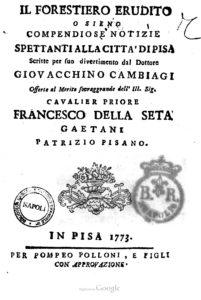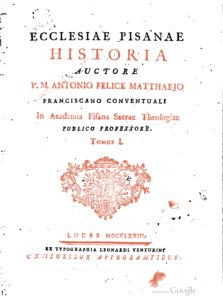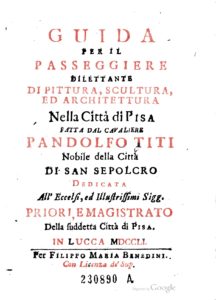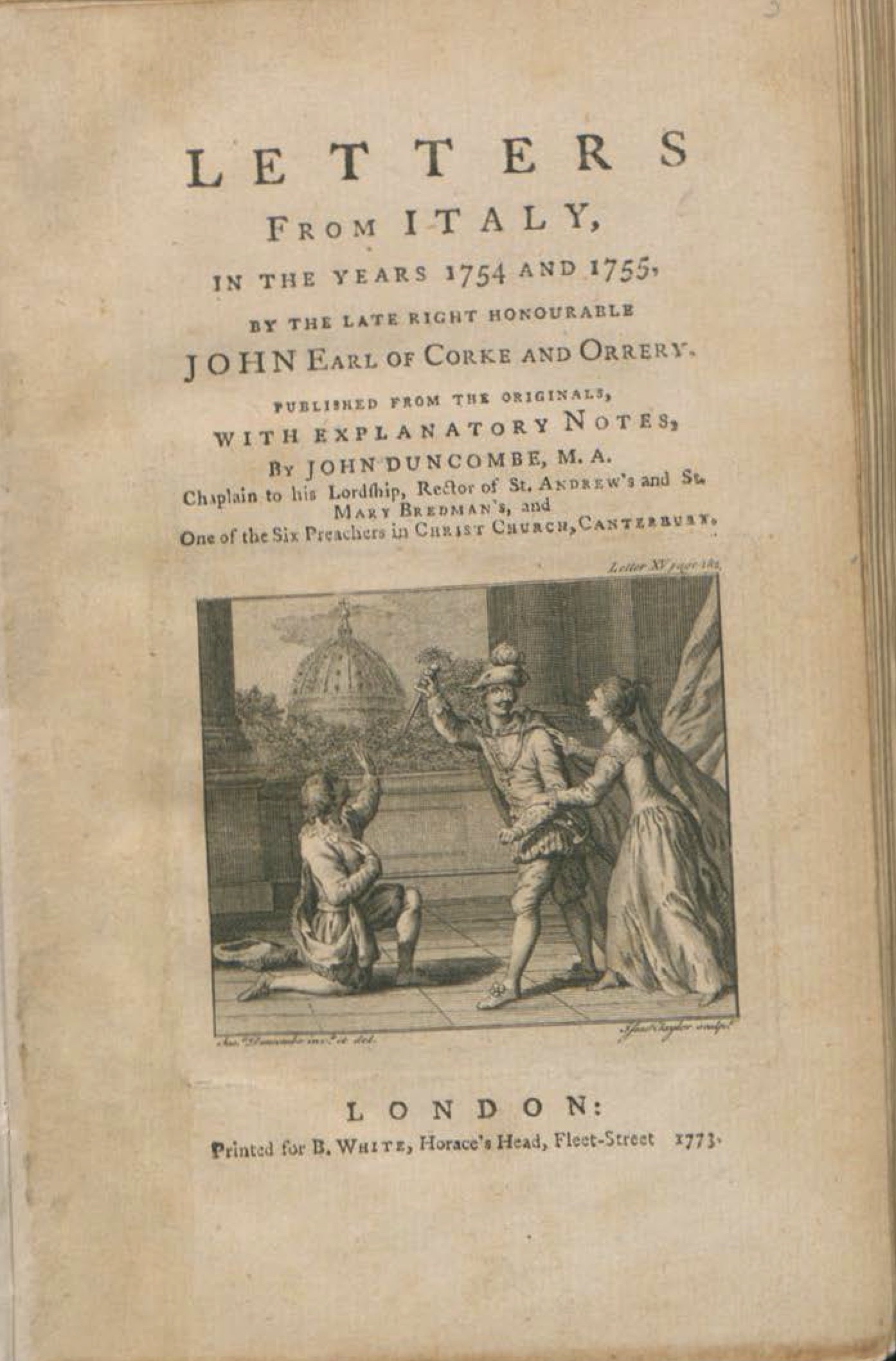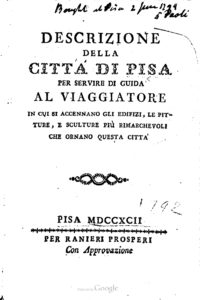
In his Descrizione della città di Pisa of 1792, Ranieri Prosperi gives an account of the history of the Camposanto, the architecture and the paintings. He agrees with other authors that it was Archbishop Ubaldo who brought the earth from the Holy Land and that he was the one who founded the Camposanto, although it was only in 1278 that the actual construction began under the archbishop Federico Visconti, with Giovanni Pisano as the master builder. His description of the building is quite detailed, and he too mentions the now-lost power of the earth to decompose bodies within twenty-four hours. Not only does he write about the architecture, he also discusses several paintings and painters, and refers to Vasari on different occasions. He also talks about the condition of the paintings. / SB
Prosperi, Descrizione_della_città_di_Pisa_1792 (excerpt)
Source: Ranieri Prosperi, Descrizione della Città di Pisa per servire di guida al viaggiatore (Pisa: Ranieri Prosperi, 1792), 68, 70-71.
Capitolo Quinto. Il Campo-Santo
“Questa magnifica fabbrica fu ideata dall’Arcivescovo Ubaldo Lanfranchi che ritornando da Soria, dove i Pisani erano concorsi con molti altri popoli d’Europa, e dove furono battuti dal valoroso Saladino, portò seco cariche le navi della flotta Pisana, ch’egli comandava, di terra presa sul monte Calvario, e comprato un sito presso la Primaziale ve la pose tutta, e destinò il luogo ad uso di Cimitero. Nel 1278 essendo Arcivescovo Federico Visconti si diè principio alla grandiosa Fabbrica sotto la direzione di Giovanni Pisano, che la condusse a fine nel 1283 e andò poscia al servizio del Rè Carlo I figlio di Luigi VIII a Napoli.
Sotto l’Arcivescovo Filipp de Medici nel 1461 fu condotta al segno a cui la vediamo presentemente, come risulta da un’iscrizione interna di cui si parlerà in appresso.
L’edificio ha la forma di un rettangolo di cui la totale lunghezza è braccia 222 la larghezza braccia 76, l’altezza braccia 24, il circuito braccia 596, l’area braccia 16872.
La facciata meridionale è divisa in 43 Arcate e spartimenti formati da 44 pilastri. Tanto i capitelli che i corniciami sono lavorati a intaglio è nel punto in cui si uniscono gli archi sopra i capitelli si vede una testa di differente figura. Tutto quest’Edifizio, è di marmo bianco.
La facciata orientale è ornata nella stessa foggia, ma è impedito di verderla da un magazzino. Non così la facciata occidentale, e settentrionale, che sono nude, ma che sarebbero state fregiate ugualmente, se si fosse eseguito il piano, che vi aera, di ampliare da quella parte la Città e per conseguenza buttar a terra le mura della medesima che sono contigue a questo bel Cimitero, e rendono inutile l’ornamento.
Due Porte aprono l’ingresso in quest’Edifizio. La più occidentale è sempre serrata ed era anticamente la più frequentata, vi era sopra un Crocefisso d’alabastro opera di Nicola Pisano, che è stato recentemente trasportato in S. Michele in Borgo, ed un Leone, che dava il nome ad una Porta della Città lì vicina, che fu murata quando Cosimo I fece aprire l’altra Porta attualmente detta Porta S. Maria o Nuova. L’altra Porta più orientale, ch’è la sola ad aprirsi, presentemente è ornata d’una specie di Tabernacolo di marmo bianco che posa sopra due colonne di marmo rosso, con vari fregi all’uso Gotico. In esso si vedono sei Statue fra le quali è rimarcabile quella dello Scultore stesso Giovanni Pisano genuflessa davanti alla Madonna.
Entrati per questa Porta veggonsi quattro loggiati in parallelogrammo che lasciano in mezzo un vasto spazio scoperto, dove fu messa la terra portata dal Calvario. Dicesi che questa terra avesse l’attività altre volte di consumare in ventiquattr’ore i cadaveri che in essa si sepellivano. Siccome poco importa una virtù che non esiste più non ci diffonderemo a esaminare se questo è stato mai vero, per qual ragione la terra del Calvario l’avesse, e perché poi la perdesse.
La pianta di quest’Edifizio è alquanto romboidale, il percheè non si sa ed è vano investigarlo. La lunghezza interna di tutto il Paralellogrammo e braccia 217. La larghezza braccia 72. Il giro braccia 578. Ogni loggiato è largo 18 braccia. E lo spazi sterrato che rimane in mezzo ha braccia 181 di lunghezza e 36 di larghezza, braccia 434 per conseguenza di giro.
I quatto gran Loggiati sono sostentute da 62 arcate rotonde di gotica Architettura, 26 nei lati maggiori, e 5 nei minori del paralellogrammo. 66 gran pilastri le sostengono, e questi posano sopra un piedistallo continuato con i rispettivi risalti delle teste di varie figure, fra le quali molte eleganti e ben lavorate adornanon il punto ve gli archi si uniscono sopra ogni capitello, e molte di queste sono avanzi di Fabbriche Romane.
Molti sarcofagi antichi sono collocati intorno al detto imbasamento de’ pilastri, benchè la più parte siano guasti dal tempo, e per essere stati luna età allo scoperto, e perciò esposti all’ingiurie dell’atmosfera, pure ve ne sono di quelli che meritano osservazine particolare, come anderemo notando in appresso, questi sarcofagi sono di bel marmo Pario la più parte, ed altre di marmi fini nostrali, sono soperi di bassi rilievi rappresentanti Storie e Favole diverse, mostri, sfingi, nercidi, divinità, ma prima di seguitarne il dettaglio, fa d’uopo terminare la descrizione de’ loggiati.
Sei arcate sono aperte per dar l’ingresso allo sterrato in mezzo, e le altre sono divise da due colonnette che reggono picoli archi, i due estremi de’ quali posano ciascheduno sopra un pilastrino in mezzo il tutto è lavorato a intaglio. Si vede che questi archi minori dovevano essere chiusi da invetriate all’uso antico. Non fu eseguito il progetto, per la qual cosa restarono prive le pitture a fresco d’un riparo contro le intemperie dell’aria.
Passiamo a descrivere queste pitture. Sono a fresco, dipinte sopra un’intonaco di calcina e sabbia fine. Non sono modelli dell’arte perfezionata, ma bensì dell’arte nascente, e fanno onore al secolo XIV in cui furono eseguiti dai più abili Professori di quell’età.
Comincieremo dalla parte Occidentale voltando a mano sinistra appena entrati dall’accennata Porta principale. S’incontrano subito sei gran Quadri tre sopra e tre sotto, ove è dipinta la vita del glorioso S. Ranieri. Autore di quelli di sopra è Simon Memmi Sanese, Antonio detto il Veneziano de’ tre inferiori. Nel primo de’ Quadri superiori rappresentasi il Giovine Ranieri che si da bel tempo un compagnia di leggiadre femmine, e che quindi punto dall’ammonizioni del Beato Alberto si pente de’ suoi errori e ne chiede perdono a Dio. Questo Quadro è ancora passabilmene conservato. Il secondo lo rappresenta in atto di partire per la Palestina e giunto a Tiro rapito in estasi per la visione della Madonna. Questo Quadro è un poco più guasto dell’antecedenti. Il terzo lo rappresenta tornato di Terra Santa, tentato dal demonio, e quando sul Tabor vide Gesù Cristo, Moisè ed Elìa.
I tre Quadri inferiori vengono riputati i migliori di questo Edifizio, e sono ancora i meglio conservati specialmente il primo. Questo rappresenta S. Ranieri sulla nave ritornando a Pisa dalla Terra Santa e partendo da Joppe. Vi si vede il miracolo ch’egli operò a Messina per discoprire la frode d’un Oste, e finalmente quando fu ricevuto in Pisa alla mensa de’Canonici del Duomo. Il secondo Quadro esprime la morte del suddetto Santo entro la Chiesa di S. Vito, e il suo rapimento in Cielo. Il terzo Quadro esprime vari miracoli che operò il Santo, mentre portavasi a seppellire il suo cadavere.
Il secondo spartimento contiene altri sei Quadri, tre sopra e tre sotto, come l’antecedente, il lavoro è di Spinello Spinelli Aretino, ma molto guastato. Eccone i soggetti. Vi si esprime la storia de’ SS. Efeso e Potito. Il primo Quadro superiore rappresenta Diocleziano che accetta nella sua Armata il giovine Efeso. Quindi il viaggio di questi per il mare in Italia, e finalmente, l’apparizione di Cristo che gli vieta di perseguitarlo in Sardegna. Il secondo Quadro contiene la storia della Bandiera della fede portata da un Angelo a S. Efeso, al quale accenna una mischia tra i Pagani e i Cristiani in Sardegna. Il terzo Quadro rappresenta S: Efeso innanz al Pretore dell’Isola, il suo esame, quindi è gittato in una fornace ardente le di cui fiamme si rivolgono contro i Ministri.
Il primo Quadro inferiore rappresenta la traslazione de’ Corpi de SS. Efeso e Potito dalla Sardegna a Pisa. Vi si vede la processione, e la facciata del Duomo. Nel secondo Quadro è espresso il martirio di detti SS. Efeso e Potito decapitati. Il terzo Quadro appartiene alla storia de’ medesimi Santi, ma è guasto a segno che nulla vi si può distinguere.
Eccoci al terzo spartimento dove il famoso Giotto espresse molto prima che fossero fatti i due precedenti spartimenti in sei Quadri la storia di Giobbe, delle quali opere scon sommo dispiacere rimangono i frammenti e i ritocchi da Stefano Marucelli [?] fattivi nel 1623 così è inutile parlarne.
Il resto delle pitture che coprono questa facciata fino all’angolo fu opera per quanto dice il Canonico Totti d’un certo Nelli di Vanni pittore da Pisa che seguitò la storia di Giobbe incominciata dal Giotto, ma il tutto è sì guasto che fa compassione, e non giova descriverlo.” (68-76)
“Giunti alla facciata settentrionale vediamo nei primi spartimenti quattro storie della Creazione del Mondo, opera di Bonamico Buffalmacco Pittore del principio del secolo decimoquattro. Nel primo gran Quadro è Dio che sostiene l’universo. S. Agostino e S. Tommaso sono negli angoli da basso. Il secondo Quadro nell’ordine superiore rappresenta la Creazione dell’Uomo, la formazione della Donna, e il loro esilio da Eden. Il terzo il Sacrificio di Caino, e d’Abele, coll’uccisione di quello. Il quarto in tre divisioni contiene la costruzione dell’arca, il diluvio, e il sacrifizio di Noè dopo l’uscita dall’arca. Questo lavoro è fregiato di quadrature ed ornati con teste e ritratti, fra i quali quello di Buffalmacco stesso con un capuccio in capo, ed un cencio che gli pende sul collo.” (81-82).
“Le pitture che adornano quest’altra parte della facciata a sinistra escendo dalla Cappella [del Pozzo] sono del Buffalmacco. La prima esprime la Crocifissione del Salvadore, la seconda la Resurrezione alla vita, la terza l’Ascensione al Cielo. Opere lodatissime dal Vasari.
Siamo giunti di nuovo alla facciata Meridionale, della quale abbiamo descritta una parte cominciando a mano sinistra dalla Porta per cui siamo entrati. Parleremo primieramente delle Pitture e quindi de’ Cenotafi ed altri ornamenti come si è fatto dell’altre facciate. E principiando per ordine accenneremo il gran Quadro a fresco diviso in più parti ove è dipinto il Trionfo della Morte. Autore di questo fu Andrea Orcagna Fiorentino che fiorì alla metà del secolo XIV. Il soggetto è tolto dal Petrarca, ma non saprei chi sia più gran Pittore, chi parli più all’immaginazione o Petrarca o Andrea Orcagna. Disapproviamo per altro quegli scritti che esprimono i sentimenti delle persone effigiate, in una pittura deve parlar la pittura e nient’altro, altrimenti si rammenta Sancio Pansa Scudiero di Don Chisciotte che credeva d’aver dipinto un Gallo, quando fatti due scarabocchi sul muro vi scriveva sotto: Questo è un Gallo.
Quì al solito sono espressi molti ritratti di personaggi e d’amici del Pittore, noi non staremo ad individuarli, perché non v’hanno altri ritratti interessanti che quelli delle persone da noi amate. […]” (92-93).
Ripiglieremo dunque la descrizione delle pitture. Il secondo gran Quadro è uno dei meglio conservati, rappresenta il Giudizio Universale ed è opera del medesimo Orcagna che dipinse qui accanto l’accennato triondo della morte. Vi è molto del bizzarro, e merita osservazione. Il susseguente Quadro è di Bernardo Orcagna fratello d’Andrea fu chiamato a Firenze. Il soggetto è l’inferno di Dante quale del Pittore o del Poeta sia stato più bizzarro è fantastico non è facile a decidersi. So bene che il Poeta è qualche volta sublime e divino, il Pittore è sempre capriccioso ed uniforme. Questa pittura fu ristaurata in alcuni luoghi nel 1530 da Solazzino Pittore, per quanto dice il Vasari.
L’ultimo Quadro rappresentante storie d’Anacoreti è di Pietro Laurati Sanese discepolo di Giotto. Sotto questa pittura e sopra una cassa di marmo è dipinto il Beato Oliverio giacente da Antonio Veneziano conforme asserisce il Vasari. Qui presso un sepolcro antico sono risposte l’ossa del Beato Giovanni della Pace, con una lapida nel muro su cui è scritto un cattivo Epigramma allusivo a quel pio personaggio.
Sulla Porta per la quale siamo entrati è internamente dipinta un’Assunzione da Simone Memmi Sanese. È ben conservato e fa onore al suo Autore, uno de’ primi Pittori nel secolo XIV. Ecco descritte tutte le pitture e i sarcofagi che sono sul muro e lungo il muro di quest’Edifizio, passiamo ora a dar contentezza dei sarcofagi che girano lungo l’imbasamento sul quale posano i pilastri che sostengono le arcate de’quattro loggiati.” (94-95).
Fifth chapter. The Camposanto.
This magnificent building was conceived by Archbishop Ubaldo, who returned from Soria, where the Pisans fought with many other peoples of Europe and were defeated by the valiant Saladin. He brought earth that he had taken from Calvary with the ships he commanded and bought a piece of land on the Primaziale, where he poured out the earth and made the place a cemetery.
In 1278, under Archbishop Federico Visconti, the construction of this great building began under the direction of Giovanni Pisano, who directed it until 1283, when he entered the service of King Charles I, son of Louis VII in Naples.
In 1461, under Archbishop Filipo de’Medici, the building was brought to the state in which we can see it today, as can be seen from an inscription that will be discussed below.
The building has the shape of a rectangle with a length of 222 armlengths, a width of 76 armlengths, a height of 24 armlengths, a perimeter of 596 armlengths and an area of 16872 armlengths.
The south facade is divided into forty-three arcades and partitioned by forty-four pilasters.
Both the capitals and the cornices are carved, and in the place where the arches are connected above the capitals, there is a head of another figure.
The entire building is made of white marble. The eastern facade is ornamented in the same style, but not the western and southern facades, which are undecorated. They would have been ornamented if the plan had been carried out to enlarge the city on this side and tear down the medieval wall that bordered this beautiful cemetery, making ornamentation unnecessary.
Two doors are at the entrance to this building. In the far west there was a cross in alabaster by Nicola Pisano, which had always been the most visited, and was recently transported to S. Michele in Borgo. There was also a lion that gave its name to the city gate, but it was walled up when Cosimo I had the other gate, called Porta S. Maria or Porta Nuova, opened.
The other door to the far east, which is the only one that can be opened, is decorated with a white marble tabernacle that stands on two red marble columns and is decorated with various Gothic sculptures. There are six statues inside, of which the one by Giovanni Pisano of the sculptor himself kneeling before the Madonna is particularly noteworthy.
Entering through this door, one sees four loggias on four sides of a parallelogram; in the center is a large open space where the earth brought by the knights was distributed.
I said that this earth sometimes decomposes the cadavers buried in it within twenty-four hours. Since a virtue that no longer exists counts for little, we will not go on to investigate if it ever had it, which part of Calvary it came from, and why it lost that virtue. The floor plan of this building is somewhat rhombic, the reason is not known, and it is not worth investigating.
The inner length of the whole paralellogram is 217 armlengths. The width is 72 armlengths. The perimeter is 578 armlengths. Each loggia is 18 armlengths wide. And the unplastered area that remains in the center has a length of 181 armlengths, a width of 36, and a perimeter of 434 armlengths.
The four loggias are supported by sixty-two round arches of Gothic architecture. Twenty-six of them are on the main sides and five are on the minor sides of the paralellogram.
Sixty-six large columns support them, and these rest on a continuous base with the respective heads of various figures, many of which are elegant and well-crafted. The columns are connected to the arches with capitals, many of which are remains of Roman buildings.
Many ancient sarcophagi have been placed around the aforementioned pilasters, most of which have aged with time and have long been in the open, where they have suffered from weathering. Of these, there are some that deserve special attention, as we will see below. These sarcophagi are mostly made of beautiful Parian marble and some are of their own fine marble. They are covered with bas-reliefs depicting various stories and fables: monsters, sphinxes, nereids, deities. But before turning to the details, let’s finish the description of the loggias.
Six arcades serve as entrances to the unplastered surfaces in the center, and the others are divided into two rows crowned by small arches. The two outer ones rest on pillars and everything is carved in the center. It can be seen that these small arches had to be closed with glass in the ancient manner. The project was not carried out in such a way that the frescoes remained protected from the intemperances of the air.
Let’s proceed to describe those paintings. They are done in fresco, on an intonaco of lime and fine sand. They are not examples of a perfected art, but of art in a nascent state, and pay tribute to the thirteenth century, since they were executed by the most capable masters of the time.
Let’s start in the western part by turning to the left at the aforementioned entrance. Right next to it are six large paintings, three above and three below, in which the life of St. Ranieri is painted. The upper ones are by Simone Memmi, the Sienese, and Antonio, called Veneziano, made the three lower ones. The first of the paintings depicts the young Ranieri who, after a long time, came together with a graceful woman and, through the admonitions of St. Albert, repents of his mistakes and asks God for forgiveness. This painting is acceptably preserved. The second painting depicts his departure for Palestine and his arrival at Tyre, where he has an ecstatic vision of the Mother of God. This painting is a bit more damaged than the previous one. The third painting depicts the return to the Holy Land, a temptation by a demon and how he saw Jesus Christ, Moses and Elijah on Mount Tabor.
The three lower paintings are considered the best in the building and they are still the most well-preserved, especially the first one. This one depicts St. Ranieri on the ship returning to Pisa, leaving the Holy Land and Jaffa. We can also see the miracle he performed in Messina, where he uncovered the fraud of an innkeeper, and how he finally returned to Pisa, to the table of the canons of the Cathedral. The second painting shows the death of the saint in the church of St. Vitus and his rapture in Heaven. The third painting portrays the various miracles that the saint performed as his body was buried.
The second section contains another six paintings, three above and three below. Like the previous one, they are painted by Spinello Aretino, though they are now in poor condition. Here are the subjects. One sees the story of the saints Ephesus and Potito. The first painting in the upper row shows Diocletian taking the young Ephesus into his army; then their journey through the sea to Italy; and, finally, the appearance of Christ, who forbids them to pursue him to Sardinia. The second painting contains the story of the flag of faith brought by an angel to St. Ephesus, including a battle between pagans and Christians in Sardinia. The third painting shows St. Ephesus in front of the praetor of the island, his trial, and how he is finally thrown into a fiery furnace whose flames are directed against the ministers.
The first painting in the lower row shows the translation of the body of saints Ephesus and Potito from Sardinia to Pisa. One can see the procession and the facade of the Cathedral. The second painting depicts the martyrdom of the aforementioned saints Ephesus and Potito by decapitation. The third painting belongs to the history of the same saints, but is in such bad condition that you can not make out anything.
Here, we are in the third section, where the famous Giotto painted the story of Job, long before the two previous sections were divided into six paintings. Of these, however, only the retouchings and fragments of Stefano Marucelli [?] are preserved, which he made in 1623, so it is useless to talk about them.
The rest of the paintings that cover this facade to the corner are, according to Canon Totti, by a certain Nelli di Vanni, a painter from Pisa, who followed the story of Job begun by Giotto, but the whole is so damaged that it inspires pity, and it is not useful to describe it. (68-76)
Arriving at the northern facade, we see four stories of the Creation of the World by Buonamico Buffalmacco, a painter from the beginning of the fourteenth century. In the first large painting is God who supports the universe. St. Augustine and St. Thomas are in the corners below. The second painting in the upper register shows the Creation of man, the Creation of woman and their Expulsion from Eden. The third one shows the sacrifice of Cain and Abel with the murder of the latter. The fourth painting is divided into three parts, depicting the building of Noah’s Ark, the Flood and Noah’s sacrifice after the use of the Ark. This work is decorated with squares and adorned with heads and portraits, among which is that of Buffalmacco, with a hood on his head and a rag hanging around his neck.
The paintings that decorate the other part of the facade on the left side, coming out of the chapel [of Pozzo] are by Buffalmacco. The first one shows the Crucifixion of the Savior, the second the Resurrection to life, the third the Ascension. Vasari praised these works.
Arriving at the south facade, we describe a part that begins on the left side of the door through which we entered. Now let’s talk first about the paintings and then about the cenotaphs and the other ornaments, as with the other facades. And we begin with the order in which we see the great fresco painting, divided into several parts, in which the Triumph of Death is included. The Florentine Andrea Orcagna, who flourished in the middle of the fourteenth century, created it. The subject is taken from Petrarch, but I don’t know who is the greater painter, who appeals more to the imagination, Petrarch or Andrea Orcagna,. We also disapprove of the writings that describe the feelings of the figures depicted, because in a painting, the painting must speak and nothing else, otherwise we remember Sancho Panza, the squire of Don Quixote, who thought he had painted a rooster when he painted two blobs on the wall and wrote underneath: this is a rooster.
Here, as usual, there are many portraits of people and friends of the painter, but we cannot identify them because there are no other more interesting portraits than those of the people we love. (92-93)
So we resume the description of the paintings. The second large painting is one of the better preserved, shows the Last Judgment and is a work by the same Orcagna, who painted the aforementioned Triumph of Death close by. There is much bizarreness here, and it is worth looking at. The following painting is by Bernardo Orcagna, who is the brother of Andrea, who was summoned to Florence. The subject is the Inferno of Dante. Whether the painter or the poet was more bizarre and fantastic is not easy to decide.
This painting was restored in some spots in 1530 by the painter Solazzino, according to Vasari.
The last painting shows the story of the Anchorites and is by the Sienese painter Pietro Lorenzetti, a pupil of Giotto. Under this painting and above a marble chest is the Blessed Oliverio lying down, painted by Antonio Veneziano, says Vasari. Below this, in an ancient coffin, are the bones of Blessed John of Peace with a stone tablet in the wall in which a bad epigram alludes to this pious person.
Above the door through which we entered, inside, is the Assumption of Mary by Simone Memmi of Siena. It is well preserved and does credit to its creator, one of the most excellent painters of the fourteenth century. Here are described all the paintings and sarcophagi that are on or along the walls of this building. Let us now move on to the sarcophagi that are located along the foundation that supports the pilasters that carry the arches of the four loggias.” (94-95)


